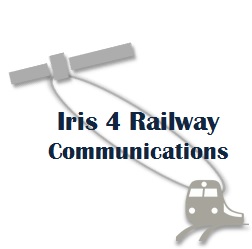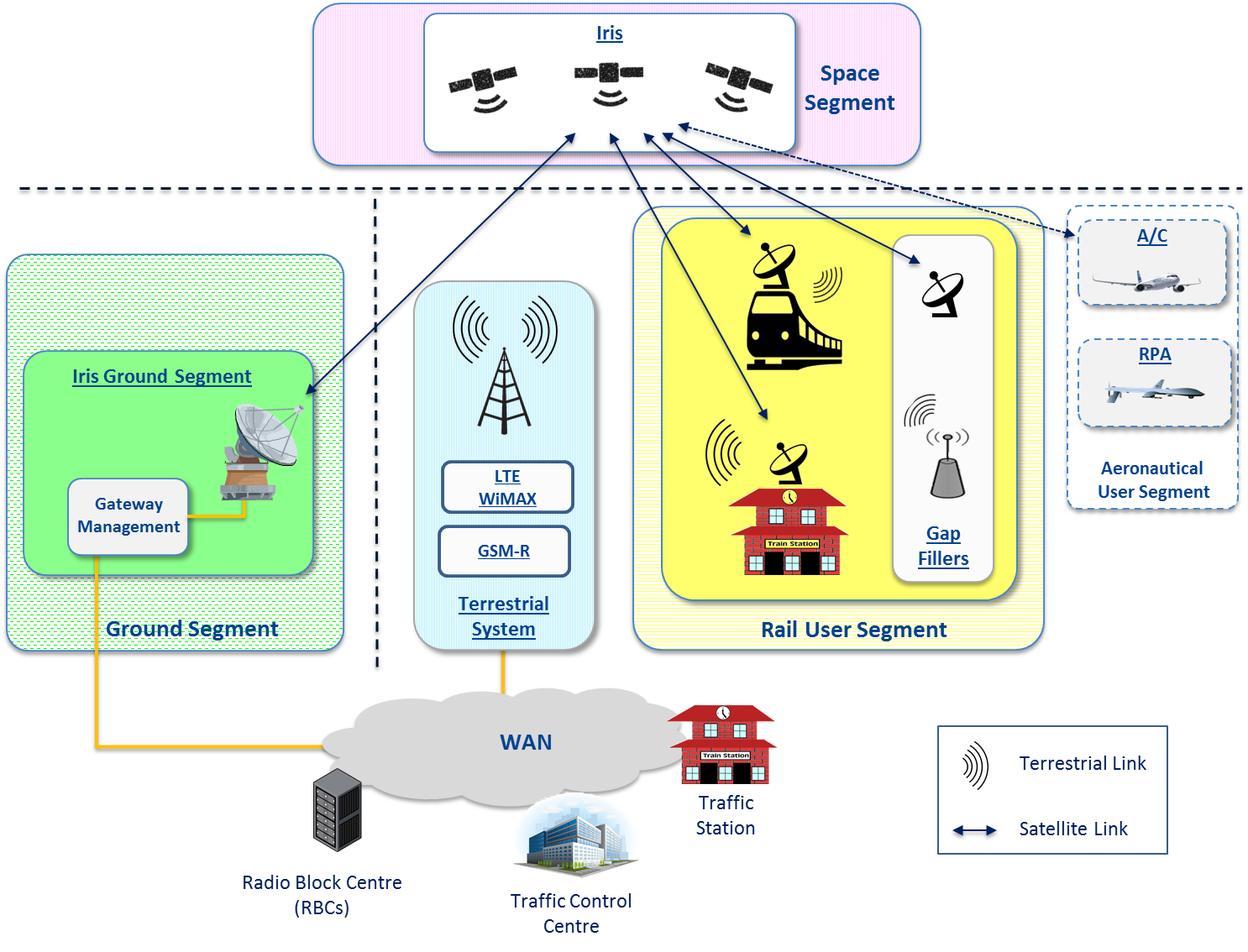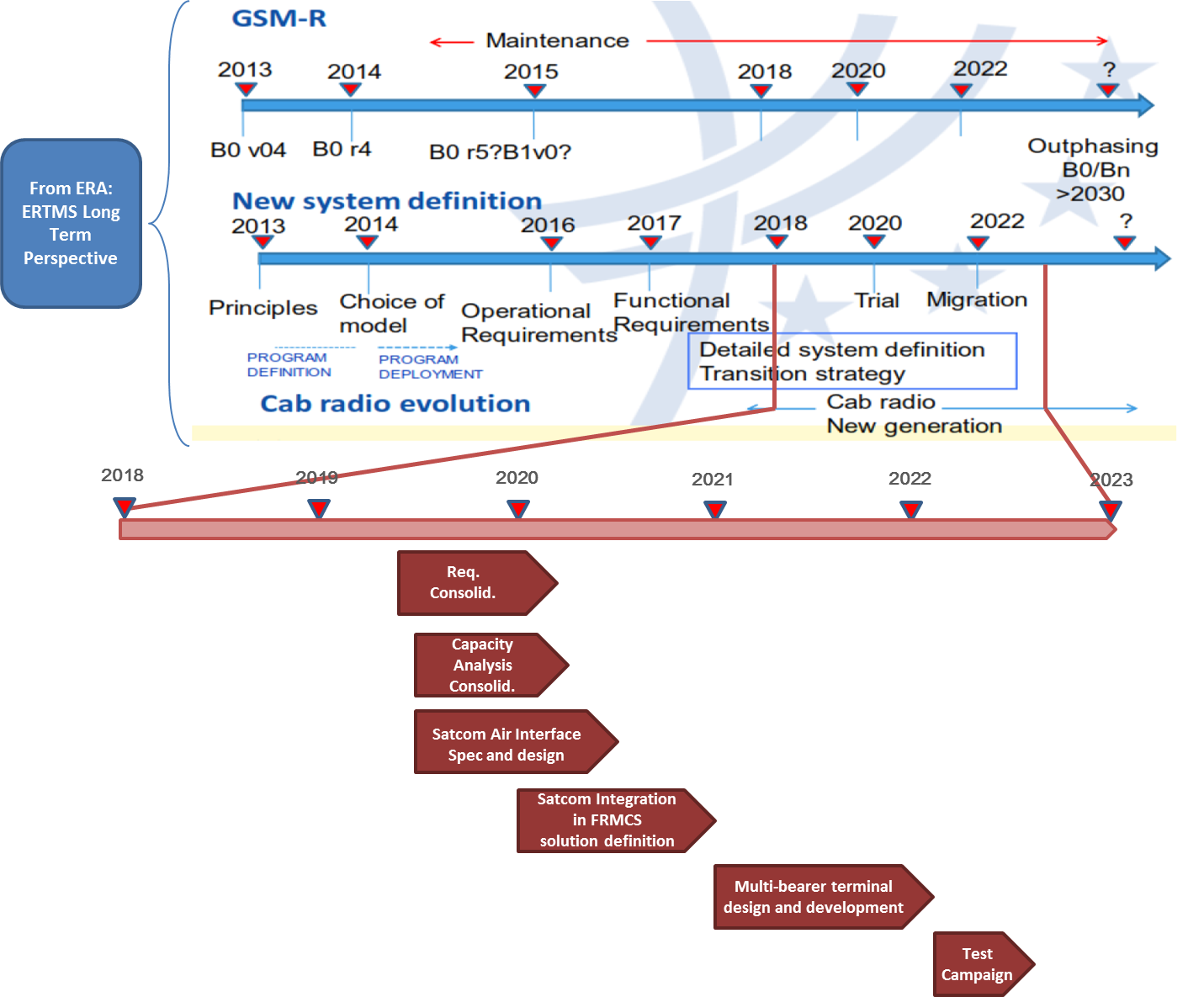Iris4Rail - Iris for Railway Communications

Programme |
Activity |
Status |
Thematic areas |
|---|---|---|---|
ARTES Future Preparations |
General |
Completed |
Signalling |
The “Iris for Railway Communications” (Iris4Rail) study has the objective of performing a feasibility assessment of the Iris Satellite Communications (SatCom) solution (https://artes.esa.int/iris/overview), which has been specifically defined for the aeronautics domain, in the railway operational scenario.
The study, which started in April 2018 and was concluded in March 2019, has been performed by an industrial consortium composed of Thales Alenia Space in Italy, acting as leader, and Indra Sistemas.
The key objectives of the Study are the following:
- To identify the technical requirements and architecture of a satcom based solution (space, ground and user segment) to be used in the Future Rail Mobile Communications System (FRMCS) bearer flexible scenario;
- To develop a railway traffic dimensioning tool to allow the estimation of communication traffic requirements in input to Iris for rail satellite system;
- To assess the suitability of the Iris system for the proposed solution;
- To assess the suitability of the Iris service provision concept for the railway environment, highlighting differences and complementarities;
- To provide a technological roadmap based on the performed gap analysis;
- To identify an approach for cost estimation;
- To disseminate the results.
BENEFITS
The European Commission has highlighted the risk of obsolescence and saturation of the current terrestrial railway communication system (GSM-R) by 2030. The Future Rail Mobile Communications System (FRMCS) and the European Union Agency for Railways (ERA) programmes have the objective of identifying solutions for a successor of GSM-R, and ERA “Study on feasibility of SatCom for railway communication” has analysed several SatCom system solutions with the outcome that there is no currently deployed SatCom system meeting all the simultaneous criteria for railway safety applications (i.e. critical).
Among the planned systems, the Iris FOC (Full Operational Capability) is a candidate solution to complement existing and planned terrestrial communication systems for rail, and is the best positioned to meet the criteria for critical applications.
Extending the scope of the Iris service can provide, as major benefit, an extended set of end-users with the same service infrastructure.
FEATURES
In the Iris4Rail Communications System Architecture, the satellite communication system is part of a wider railway communication system composed of a terrestrial and a satellite component.

Iris4Rail Communications System Architecture (terrestrial + satellite)
The main functionalities are distributed among the different domains of the Iris for Railway communication operational scenario.

Main Functionalities Apportionment to Iris4Rail Communication Domains
The service scenarios are defined according to FRMCS User Requirements Specification where two different typologies of area of operation are considered:
- Station: Railway station with platforms. This area of operation can be linked to the the stations or shunting areas scenario.
- Line: Railway track between two stations. This area of operation includes the Low Density, High Density and High Speed sub-scenarios.
The considered applications are categorised as follows:
- Critical (e.g. railway emergency, ATC) – including all the applications necessary for the train movement and safety or legal obligations;
- Performance (e.g. telemetry, video surveillance) – including those applications that help the performance improvement of railway operations.
Business applications (e.g. internet in trains for passengers) are out of the scope.
The complete stream of activities performed in the Study is:
- Identification of the technical requirements of a Satcom based solution to be used in the FRMCS bearer flexible scenario;
- Definition of the system architecture of a Satcom based solution (space, ground and user segment) to be used in the FRMCS bearer flexible scenario;
- Definition of the operational scenarios;
- Development of a railway traffic dimensioning tool to allow the estimation of communication traffic requirements in input to Iris for rail satellite system
- Assessment of the suitability of the Iris system for the proposed solution with respect to the following aspects:
- Iris air interface in railway propagation channel;
- Impact of geostationary orbit delays with regard to Quality of Service (QoS) requirements;
- Multi Access Core Network and integration with FRMCS;
- L2 handover analysis;
- Upper layer optimization;
- System Failure Analysis;
- Identification of the system gaps based on the performed suitability analyses;
- Definition of an approach for cost estimation;
- Dissemination of the results.
The following main conclusions and recommendations are derived from the Satcom for railway technical requirements identification activities:
- Satellite communications can provide benefits to the railway community (particularly global coverage, backup service).
- It is understood that other bearers (e.g. terrestrial) will be available in more congested areas where railway traffic is denser and voice calls are much more likely to take place. Therefore, the focus for satcom may be in low-density areas and for control-critical applications (mostly European Train Control System (ETCS) data and voice mostly as emergency).
- The recommendations are, therefore:
- To further refine “critical” applications into “control-critical” and “non-control-critical”;
- “Control-critical” applications would cover mostly ETCS data and emergency voice
- Specify different sets of requirements for high-density and low-density areas;
- Possibly combine L-band (control critical) and optional Ku/Ka band (non-control-critical, high bandwidth).
The overall objective would be to be able to specify a subset of applications with carefully adjusted requirements in order to be able to provide services to the railway community (e.g. additional coverage, backup service, etc.)
With respect to the traffic capacity analysis, a Railway Traffic Dimensioning tools is developed, providing an instrument for the estimation of the railway data traffic to be supported by SatCom, generated by a single railway user and aggregated for a customisable region.
The analysis scenarios take into account FRMCS User Requirements and the outcomes of the Satcom for Railway Technical Requirements.
Finally, based on the outcomes of performed technical analyses, a gap analysis and a Preliminary Technological Roadmap have been identified, as reported in the figure.

Preliminary Technological Roadmap
As a conclusion, the following two main recommendations are derived from the performed activities and are agreed amongst all the participants of the “Iris4Rail Final Presentation and Dissemination Event” hosted by ESA at ESRIN premises in Frascati, on 14 March 2019:
- To intensify the interactions with the railway community in order to consolidate the user requirements that are critical for the use of Satcom in the railway environment.
- To work on the technological aspects identified in the gap analysis and preliminary technological roadmap.
STATUS
The Study has been completed.
The performed activities and key achievements are:
- The review and consolidation of system technical requirements, with the identification of the quantitative figures for the selected criteria and a preliminary assessment against the planned Iris system. The Requirements Review was held in July 2018.
- The presentation to the ETSI Workshop "Developing the Future Radio for Rail Transport", 4-5 July 2018, ETSI, Sophia Antipolis, France, as first dissemination step and starting point for the liaison with standardization groups, stakeholders and users.
- The execution of the Suitability Review held in December 2018, covering the following tasks:
- Definition of the system architecture and operational scenarios;
- Development of a railway traffic dimensioning tool and execution of capacity analyses for a set of reference scenarios;
- Iris system suitability technical analyses;
- Identification of the system gaps based on the outcomes of the performed suitability analyses;
- Definition of a preliminary technological roadmap of development and testing based on the outcomes of the gap analysis.
- The execution of the Final Review in March 2019, covering a preliminary viability analysis of the Iris System Provisioning for railway environment and the execution of the “Iris4Rail Final Presentation and Dissemination Event”, hosted by ESA at ESRIN premises in Frascati, on March 14th, 2019, with the objectives of presenting the main outcomes of the Study and have an open discussion with the main representatives of Railway Stakeholders and the Technical Community.
Representatives of the following stakeholders and technical groups attended the “Iris4Rail Final Presentation and Dissemination Event”:- RFI (Rete Ferroviaria Italiana);
- Trenitalia;
- ASI (Agenzia Spaziale Italiana);
- UIC (International Union of Railways);
- ERA (European Union Agency for Railways);
- Shift2Rail/X2Rail;
- Inmarsat;
- DLR (German Aerospace Center).
The main achievements and conclusions are summarized in the Final Report.
CONTRACTORS
Italy
SUBCONTRACTORS
Spain
PROJECT MANAGERS
CONTRACTOR PROJECT MANAGER
Alessia
Miglietta
Address Via Saccomuro 24, Rome Italy
00100
Rome
RM
IT
First name
Last name
Street address
48013
Bilbao
BI
ES
ESA PROJECT MANAGER
Michele
Castorina
NL
Last updated date: 27 June 2022


